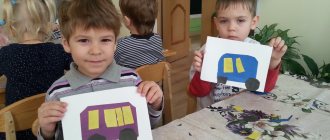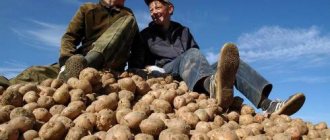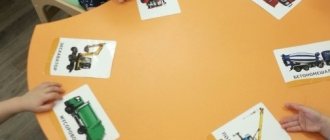Lesson notes for the middle group “Work in the garden”
Zelenskaya Tatyana
Lesson notes in the middle group “Work in the garden”
Lesson summary for the middle group.
«Work in the garden«
Goal: continue to teach children to compose a story based on a plot picture, develop monologue speech, teach them to hear, analyze, and negotiate with each other (who starts the story, who continues, who finishes)
;
activate singular and plural present and past tense verbs in children’s speech; learn to correctly use plural genitive nouns; learn to form adjectives from nouns.
Program content
- Summarize and consolidate children's knowledge about vegetable crops and their use.
- Train children in proper planting of garlic and careful use of equipment, develop skills in caring for cultivated plants.
- Introduce methods for preparing soil for planting vegetables and the characteristics of their seasonal growth and development.
- Foster independence and the desire to work together; the ability to rejoice after successfully completed work.
Materials and equipment : hoe, bucket of garlic, rakes, cord with 2 pegs, watering can with water, ruler with a bright mark (15cm), wet wipes (according to the number of children).
Progress of the lesson
A knock on the door, the arrival of a fairy-tale hero Doll Katya the gardener . She works in the garden in the spring , plants seedlings, then takes care of them: waters them, pulls out weeds, loosens the ground. The teacher draws the children's attention to the basket with which Katya the gardener . And what is in the basket we will find out when you listen carefully to the riddle I tell you
We grow, we water, we pull out weeds
Summer is coming, let's go to the garden
We can harvest a whole bag
The teacher pays attention to the table, it is not simple, it has a surprise. It contains pictures, games, fairy tales. This table is called an interactive table. Now we are going to look at pictures of fruits. Here, for example, is an apple, and if there are apples in a basket and there are a lot of them, then apples. Pear-pears, banana-bananas, plum-plums, apricot-apricots, banana-bananas, peach-peaches, peach-peaches.
Looking at the painting “ Work in the garden ”
-Who works in the garden ? (children)
-What time of year do you think this is? (Spring)
-Why did you decide so?
-What are the characters doing in this picture? (dig, loosen, carry, water, plant, dig up weeds, install arcs for the greenhouse)
And if you and I imagine what the children have been doing for a long time! How will you answer the question:
-What did the children do? (dug, loosened, watered, planted, collected, dug up.
Now imagine that you are working in the garden . What are you doing?
Now we will come up with a story based on the picture.
One warm spring day. worked together in harmony . Masha watered, Denis dug, Lisa planted, etc.
Well done! Your story is very interesting.
Physical exercise " Vegetable Garden "
We loosened, we dug, Children imitate working with a shovel.
Our little legs are tired. They stomp their feet.
And now we will rest. Hands together under the cheek.
And let's go digging again. They march in place.
Guys, do you remember there was such a fairy tale about how my grandfather went to the garden and planted... what ? Now let’s return with you to our interactive table and play the fairy tale “Turnip”. Listen carefully to what the voice that lives in the table will tell you.
Look, there are tools on my table. Now choose the tool that is suitable for working in the garden or garden and tell us what they do with it.
This shovel can be used to dig, dig, dig, dig. This is a rake. This is a watering can. It's a saw. This is an axe. This is a pitchfork. This is a chopper. This is a scoop.
The game “Clap your hands” if you hear the name of a tool necessary for working in the garden .
At the end of the lesson, the guys say goodbye to Katya the gardener . The teacher praises the children and says that the guest really enjoyed visiting us.
Summary of the lesson “In the garden, or in the vegetable garden” in the senior group “In the garden, or in the vegetable garden!” in the older group Fruits are juicy edible fruits that grow mainly on trees. These are ruddy apples, juicy and fragrant.
Collective work in the garden 1. Sowing seeds of dry and wet cucumbers, carrots and beets with plantings. 2. Planting cabbage and tomato seedlings. Program objectives: 1. Develop.
Summary of the complex lesson “In the garden, in the vegetable garden. Planting vegetable crops in the garden” in the second junior group Synopsis of a complex lesson in the second junior group “Whether in the garden or in the vegetable garden. Planting vegetable crops in the garden” Purpose: to form in children.
Summary of directly organized activities on cognitive development in the middle group “People’s work in spring” Purpose: To acquaint children with the work of adults in the spring. Objectives: • update children’s knowledge about the season - spring • repeat.
Summary of educational activities for modeling in the middle group “Gathering crops in the garden” Program content. Improve children's ability to sculpt objects by rolling out a lump of plasticine with circular and straight hand movements. Summary of an open lesson on cognitive development “Whether in the garden or in the vegetable garden” in the senior group Purpose: To consolidate children’s ideas about vegetables, fruits, the place and stages of their cultivation. Expand your vocabulary and coherent speech. Develop.
Source
Conditions and forms of organizing the work of preschool children in nature
Conditions and forms of organizing the work of preschool children in nature
Varied work in nature brings children a lot of joy and corresponds to their all-round development. In the process of work, a love for nature, a careful and caring attitude towards it is cultivated. Children develop an interest in work activity and a conscious, responsible attitude towards it. In a team, children learn to work together and help each other. Working in nature has great educational value. It broadens children's horizons and creates favorable conditions for solving problems of sensory education. Working in nature, children become familiar with the properties and qualities, states of natural objects, and learn ways to establish these properties. The teacher teaches children to focus on the properties of natural objects to perform labor actions. So, to determine whether a plant needs watering, you need to take into account its condition (elasticity, leaf and stem density). As a result, children develop a standard idea of the properties, qualities, and states of natural objects.
Working in nature, children learn in practice the dependence of the condition of plants and animals on the satisfaction of their needs, and learn about the role of man in managing nature. The assimilation of these connections and dependencies contributes to the formation of children’s attitude towards nature; their work becomes meaningful and purposeful.
In the process of working in nature, children develop knowledge:
about plants - properties and qualities of plants, their structure, needs, main stages of development, methods of cultivation;
about animals - appearance, needs, methods of movement, habits, lifestyle, seasonal changes. Children learn to make connections between conditions, the way of life of an animal in nature and ways to care for them in a corner of nature.
Work in nature contributes to the development of observation, curiosity, and inquisitiveness in children; it arouses in them an interest in objects of nature, in human labor, and respect for working people.
In the process of work, practical skills in caring for plants and animals are formed, intellectual skills are developed: planning work, selecting materials and documents, outlining the sequence of operations, distributing them over time and between work areas, evaluating results, etc.
Labor in nature creates favorable conditions for the physical development of children, since in most cases it takes place in the air, is varied in nature, and this contributes to the development of movements and strengthening the child’s nervous system.
Children's aesthetic needs are satisfied through work. Doable and interesting work brings them joy, and this is the basis for developing a future desire to work and a sustainable interest in work.
Pedagogical requirements for the organization of work in nature.
Work in nature only has educational significance if its organization and content meet certain pedagogical and hygienic requirements.
The most important pedagogical requirement is the organization of work that is varied in content: caring for animals (birds, fish, mammals), plants, growing plants in a corner of nature, work on the site (in a flower garden, in a vegetable garden, in an orchard). Only varied work arouses interest in children and a desire to participate in it.
In the process of work, it is necessary to develop practical skills and abilities in unity with knowledge. So, for example, when transplanting flowering plants from soil in the fall in the older group, the teacher consolidates the ability to distinguish and correctly name them (aster, dahlia, etc.). He introduces children to the root as a part of the plant, explains the connection between cold weather and the state of the plant, and develops the skills of replanting a plant (dig with an earthen ball; dig away from the stem so as not to damage the roots; select pots in accordance with the root system). When planting flower seeds in a school preparatory group, you should examine them, highlight the color, size, shape, etc., match the image of the flowering plant, remember the process of growing this plant before the formation of seeds, and then begin planting. With such an organization of work, the child acquires not only the skills, but also the knowledge he needs in his future work activity.
An important pedagogical requirement is awareness of work, which involves revealing to the child his goals, results and ability to achieve them.
The work activities of children in nature should systematically become more complicated. The skills of caring for plants and animals become more complex, the range of knowledge is enriched, and children’s observation and planning skills develop.
Work activity must be regular. It is important for the teacher to introduce every child to it.
Hygienic requirements for the organization of work in nature.
The work of children in nature should be feasible. The physical effort expended by the child should not cause overwork. Otherwise, he develops a negative attitude towards work assignments. The duration of work depends on its nature and the age of the children: In the younger group within 5 - 7 minutes, in the middle group - from 10 to 15 minutes, with a short rest depending on the nature of the work, in older preschool age 20 - 25 minutes, with a break for rest or change in the nature of work.
It is necessary to ensure proper breaks in children's work. So, when carrying water, watering cans or buckets must be carried in both hands; When working with a rake or shovel, the body must be kept straight. It is important that children do not stay in the same position for a long time. For this purpose, one type of work should be alternated with another (for example, loosening the soil with a water supply). The tools must be absolutely safe and correspond to the height and strength of the child, but at the same time it is necessary that the equipment is not a toy, but a real one.
Forms of labor organization in nature.
The work of children in nature is organized in the form of individual assignments, collective work and duty.
Individual orders
are used in all age groups of kindergarten, but are of particular importance in younger groups, where work activity is just being mastered. With an individual form, the child performs the entire labor process himself. This allows the teacher to teach the child labor actions, help him monitor the performance of labor operations, evaluate activities, and take into account individual characteristics. All this helps to develop labor skills and abilities, promotes responsibility for the assigned work, perseverance, accuracy, and habits of work effort.
Teamwork
in nature makes it possible to develop labor skills and abilities of all children in the group. Collective work unites children, develops the ability to accept a common goal of work, negotiate, jointly plan actions, coordinate them, help each other, and evaluate work.
In its structure, collective work can be organized as general work (several children or the whole group participate in the work, each child receives a separate task; the results of the work of all children are combined into one common result, for example: each child in a corner of nature wipes the leaves of plants , as a result, everyone together made the plants clean) and joint labor (several children participate in the labor; the labor process is divided into several operations, each of which is carried out by one of the participants or a group of children; each participant in the labor performs his own operation and passes the object on, for example: Some children dig up the earth, others level it, others make beds).
Duty roster
are one of the most common forms of organizing the work of children in kindergarten. Duty involves children alternately performing a constant and specific range of duties. In the corner of nature, children begin to be on duty in the older group. During their duties, they improve their skills in working in nature, social motives for work are formed, etc.
Contents of work and methods of guiding it in younger groups.
Kids help the teacher care for animals and plants in the corner of nature and on the site. They should be involved in joint watering of indoor plants. This teaches children how to properly water plants and wipe the strong, leathery leaves with a damp cloth.
Children plant bulbs and large seeds in the ground prepared by the teacher (in boxes, cups, soil), and water the plantings. Children should also be involved in harvesting vegetables: pulling out radishes, carrots, turnips.
Together with the teacher, the kids feed the fish and birds in a corner of nature. The food and its dosage are determined by the teacher.
Children carry out individual assignments, which include 1-2 labor operations (take ready-made bird food and put it in a feeder, water the plants with prepared water, etc.). This work is short-term, but the teacher should take the children one at a time, since it is necessary to develop basic work skills.
In the second younger group, it is possible to organize the work of the entire group of children, for example, planting onions, large flower seeds, and harvesting. This work will be organized as work nearby. Each child acts at his own pace, without any dependence on others, which is very important when children master skills. And at the same time, they develop an interest in working together.
In the second junior group, work in subgroups is possible. Two subgroups can work at the same time, but each performs the same labor operation: wiping the plants, planting peas in the beds or watering the flowerbed. This feature of the organization of work is associated, firstly, with the great imitation of children, and secondly, with the fact that it is easier for the teacher to teach them.
Teaching labor skills in nature in the younger group is characterized by a fragmented demonstration of a labor operation with the simultaneous completion of tasks by children. The teacher combines demonstration with explanations, and the children immediately carry out the labor process step by step. This fragmentation of display is associated with insufficient development of voluntary attention and memory in children.
Children's work takes place with the participation of a teacher or under his supervision. During the course, the teacher helps the children, encourages them, and shows them how to complete the task. The assessment is always positive and educational in nature. Training in new work actions is usually carried out in classes.
Contents of work and methods of managing it in the middle group.
Pupils of the middle group must independently water indoor plants, using the measure established by the teacher, wipe plants with leathery leaves, together with the teacher, maintain the cleanliness of plants with pubescent leaves, leaves with jagged leaves, with small leaves (pouring, spraying, brushing), loosening soil in flower pots. Children master the initial skills of growing plants: they help adults prepare the soil for planting on the site (leveling the dug up earth with a rake), planting large seeds and bulbs, and then watering them, loosening the soil between the rows, weeding beds with plants that are clearly distinguished from weeds (lettuce , onion).
Children take part in cleaning the area: raking leaves, shoveling snow on the paths, etc.
They learn to feed the fish and birds on their own according to the prescribed amount, and help clean the cages (wash drinking bowls, feeders, and clean the cages together with the teacher).
In the middle group, the forms of organization of children in the labor process are the same as in the younger group. Individual assignments occupy a large place, but they are longer in nature. Children can complete errands for 2 - 3 days. Working in subgroups also has its own characteristics. 2-3 subgroups can work simultaneously and perform different labor operations (but no more than two). For example, one group of children loosens the soil in pots, another wipes the plants. The skills of children in the middle group are still very imperfect, so the teacher needs constant attention to the methods of work so as not to cause damage to plants and animals.
Collective forms of labor occupy a large place. The teacher mainly uses them when it is necessary to introduce children to new work operations, for example, the method of planting seeds.
Pupils in the middle group are becoming increasingly independent as they acquire skills. They willingly carry out work assignments and help adults; they begin to develop processes of deliberate memorization and recall, the beginnings of a sense of responsibility for the assigned work and a critical attitude towards the results of their activities appear. Children of the fifth year of life begin to develop a conscious attitude towards performing labor operations, and the ability to see and feel the need to carry out a particular process is formed.
All these developmental features of children are the basis for complicating the methods of managing their work. When teaching a new labor operation, the teacher no longer gives the middle group a fractional demonstration; the entire process is shown and explained, and then it is divided into logical stages (lay a furrow, put seeds, cover with soil, water). The teacher checks the completion of each stage. As he works, he reminds him of the sequence of actions, how to use the equipment, uses demonstration, and the example of other children when helping individual children. The nature of job evaluation is also changing. Now the assessment may not always be positive, since the quality of the work operation is assessed. The teacher gives an assessment as the children work and immediately offers to correct mistakes, if any. Gradually, in the middle group, the teacher teaches children to notice the need for work. He explains why it is necessary to perform this or that labor operation: he examines the plants together with the children; runs his finger over large leaves, finding out if they are very dusty; finds plants that need to be watered (ground is damp, dry). If there is dirty sand in the cage, it needs to be changed, if there is not enough water in the aquarium, it needs to be topped up, etc.
Contents of work and methods of managing it, in senior and preparatory groups for school.
Pupils of the senior and preparatory groups for school, under the guidance of a teacher, continue to care for indoor plants: watering, loosening the soil, cutting off dry leaves, feeding plants, becoming familiar with methods of propagation, and helping to replant plants. In a corner of nature, in a vegetable garden and flower garden, they grow plants: they participate in digging up the earth and cutting up beds and flower beds, sowing seeds, planting seedlings, some of which they can grow in a corner of nature, and then watering, weeding, loosening the soil, and harvesting. Children need to develop appropriate labor skills and abilities, teach them to determine the need for one or another method of care based on the condition of plants and soil, and establish a connection between the condition of plants and human labor aimed at meeting the needs of plants.
Children continue to care for animals - inhabitants of the corner of nature, for small pets living in the kindergarten area: they prepare food and feed fish, birds, animals, wash drinking bowls and feeders, and clean bird cages. Pupils of the pre-school group provide care independently. The teacher only controls their actions and provides assistance in case of difficulty. At the same time, it is necessary to formulate the need for one or another method of care, the ability to establish a connection between the conditions that need to be created in a corner of nature for animals, and the conditions for their existence in nature.
Older preschoolers should acquire some nature conservation skills: collect seeds of trees, shrubs, wild herbs and feed birds with them, and set up drinking bowls for birds in the kindergarten area in hot weather.
Mastery of labor activity in senior and preparatory school groups occurs in more complex forms of labor organization. At this age, it is necessary to develop the ability to accept and set a work task, present the result of its implementation, determine the sequence of work operations, select the necessary material, and independently carry out the work process with a little help from adults. Individual assignments for the care of individual objects are becoming longer. A child can be entrusted with growing a plant as a gift for children, mother, or caring for a garden bed or flower bed.
In the older group, children are on duty in a corner of nature. When organizing duty, the teacher conducts a lesson in which he introduces children to the duties of those on duty, reminds them of ways to care for objects in a corner of nature, and introduces them to new ones. 2-4 people are on duty at the same time. It is important to select groups in such a way that children with insufficiently developed skills are also on duty together with children who have good skills. The duration of duty is up to two days, or up to a week. Long-term duties develop a sense of responsibility, efficiency, and stability of interests. If children are on duty for a whole week, it is possible to change responsibilities in the middle of the week. The order and sequence of assigning children to duty is recorded on the duty board aimed at developing organizational skills in caring for animals and plants, developing relationships and cultivating a positive attitude towards work. Those on duty must be able to agree on who will do what and in what sequence. The teacher’s help consists of advice, questions, reminders, etc. If those on duty are doing work to care for animals that are new to them, the teacher initially performs all work processes together with the children.
Duty assessment plays a major role in managing the work of duty officers. All children are involved in the assessment. When transferring duties, children tell the whole group how they cared for animals and plants, what new and interesting things they noticed in the development of plants and in the behavior of animals. When assessing duty, the good condition of animals and plants should be emphasized. Children evaluate the work performed by those on duty, express judgments about the quality, about their attitudes towards responsibilities and towards each other in the process of work. When assessing, one should also note the negative manifestations of the attendants (arrived late, did not have time to water the plants).
Compared to previous ages, the organization of collective work becomes much more complicated. Here there is common labor and joint labor. When organizing common labor, children are divided into subgroups. Each subgroup performs one or another task, and the result is a common one.
For example, collective cleaning in a corner of nature, collecting seeds to feed birds, etc.
The most complex type of collective labor takes place—joint labor. Work in the vegetable garden and flower garden can be organized according to this type. One subgroup digs up the beds, another loosens the ground, the third makes furrows and sows seeds. This form of labor organization creates objective conditions for the emergence of relationships determined by the very structure of the organization.
When organizing collective work, the teacher helps children break into units, distribute responsibilities between units and within units. Observing the work of children, the teacher helps them, gives advice and instructions.
The leading method of teaching children new work is to explain what needs to be done and how. Demonstration of methods of action also takes place and is used mainly when becoming familiar with a new work operation.
In connection with the general development of children, the labor process that must be performed becomes possible. Children repeat the most complex operations.
In the process of supervising children’s work, the task is to develop control and self-control: the teacher, checking the completion of the task, asks individual children questions that direct their attention to the result of the work. This technique develops self-control and the ability to correlate one’s actions with the instructions of the teacher.
The assessment is positive, but it is differentiated depending on the quality of the work: “He planted correctly, but did not press the soil around the bulb well.” The children themselves are also involved in the assessment. The teacher invites one child to evaluate the work of another in terms of completing the task. When working in subgroups, one subgroup evaluates the work of another.
A feature of work management in the senior and pre-school groups is that the teacher discusses the work process with the children (what needs to be done and how). He teaches children not only to see, but also to plan the sequence of work operations, distribute responsibilities in advance, and independently prepare all the necessary equipment.
Methodology for guiding children’s work activities in nature.
Having determined, taking into account age characteristics, the main means of cultivating a positive attitude towards work, which include play motivation used to master the sequence of work actions, interest in achieving results, in this section we will consider the most effective methods and techniques for implementing educational means.
Below are shown special studies in this direction (, , etc.) “education means are the most significant pedagogical techniques for a particular activity, methods used in the education process.
Revealing the essence, methods and techniques of instilling a positive attitude towards work in preschool children aged 4-5 years, one should turn to the directions of humanistic pedagogy. This is justified by the fact that work activity presupposes an adequate attitude towards oneself, knowledge of one’s own capabilities in the process of self-service, but also the establishment of labor relationships in the process of activity.
Namely, the ability of children to put themselves in the place of another person, a literary hero, a game character, to see things from his position, to take into account not only their own, but also someone else’s point of view. All this is very important for nurturing kindness, responsiveness, tolerance - those personal qualities of a humanistic orientation, without which the democratic path of development of modern society is impossible. The formation of a positive “I-concept” of a preschooler is associated with the development of independence as an integrative personal quality that determines the success of the child’s personality maturation.
The development of moral ideas about work is closely related to the development in children of the ability to evaluate the work of others and their own. A correct assessment indicates that the child has moral ideas related to work.
The formation of children's ideas about the moral qualities of adults in connection with work can be considered as a means of instilling in them a positive attitude towards work and on the basis of their moral qualities.
One of the main knowledge is the knowledge of mutual assistance. It is associated with a number of concepts that characterize human morality, such as comradeship, friendship, kindness, respect and compassion. The ability to come to the aid of another, responsiveness, and a sense of collectivism are associated with the level of development of an individual’s self-awareness. The simplest forms of mutual assistance among preschoolers are expressed in sympathy for a peer, caring for each other, clarity, and a desire to help a friend in some way.
The idea of a conscientious attitude to work in preschool children comes down to the following: when performing work tasks, one must be able to give up one’s desires, do not only what one wants at the moment, but what is necessary (necessary) for others, for peers in the group (meaning instilling in children the ability to self-restraint); you need to be honest about your work, fairly evaluate your actions, your attitude towards work.
Nurturing a conscientious attitude to work is closely related to instilling in children a sense of duty and conscience, which can be expressed in an emotional reaction, the child’s experience of evaluation of his actions by adults. Depending on the assessment, positive or negative, the child experiences feelings of joy, pride or, conversely, incompetence and shame.
Depending on the preschooler’s attitude towards work, one can judge the development of his moral qualities, i.e. the child’s attitude towards the worker (respect for him, desire to help, etc.), towards his work (conscientious attitude towards the results of labor, etc. . p.), which is an indicator of the formation and development of his moral qualities.
Get text






